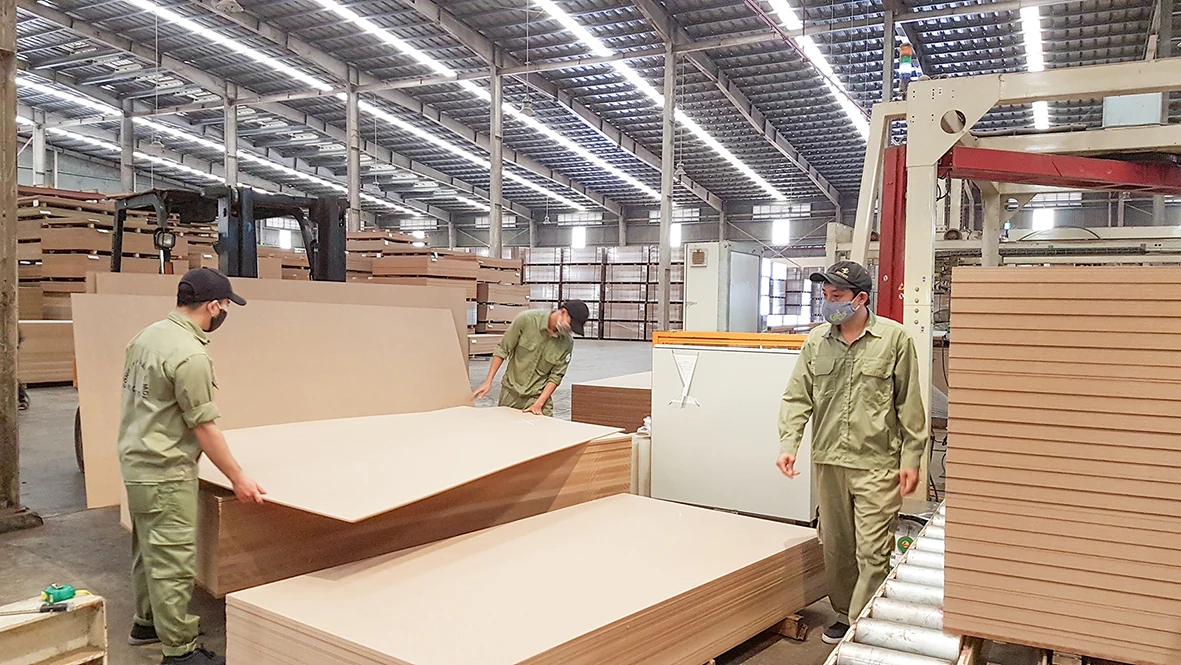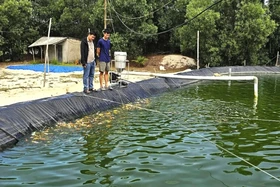{title}
{publish}
{head}
Identifying industry and handicrafts as a central focus in economic development and a driving force for economic and labor restructuring, Quang Tri Province has, in recent years, implemented a range of coordinated measures to advance this objective. As a result, the industry and handicraft sectors in the province have seen positive transformations, contributing to job creation, improving the material and spiritual well-being of the population, and promoting the province’s economic development towards industrialization and modernization.
During the early period following the re-establishment of the province, most industrial production facilities in Quang Tri developed in a small-scale, fragmented manner, still bearing strong characteristics of a centrally planned economy. These facilities had not adapted to the requirements of renovation, leading the majority into production and business stagnation, inefficiency, and widespread unemployment.

Wood panel production at the MDF wood manufacturing plant operated by VRG Quang Tri MDF Wood Joint Stock Company – Photo: M.L.
Faced with this situation, the province took advantage of its existing potential and strengths to introduce sustainable and effective economic development strategies, thereby contributing to the growth of industry and handicrafts. With the leadership and direction of the Provincial Party Committee, the People’s Council, and the People’s Committee of Quang Tri, as well as the efforts of enterprises and production facilities, the local industrial and handicraft sectors gradually stabilized and developed rapidly through different periods, achieving significant results.
Particularly since 2001, the industrial production network has expanded, with encouragement for businesses to invest in sectors where the province has existing strengths, such as agricultural, forestry, and fishery processing; beverages; mining; construction materials; and electronic components. Industries with competitive advantages have strongly developed, including wood processing, textiles and garments, and energy.
The number of industrial production facilities and workers has increased significantly. In 1989, the entire province had only 1,653 industrial production facilities with 9,969 workers. By 2024, the province had 8,015 facilities employing 25,443 workers.
The industrial production development index has continuously increased, with an average annual growth rate of 13.1%. After 35 years since the province was re-established, the number of industrial production facilities has grown by 4.8 times, the number of workers has increased by 2.6 times, and the value of production has risen more than 40 times. The economic structure has shifted towards industrialization and modernization. In 1989, when Quang Tri Province was newly re-established, the economy was mainly based on agricultural, forestry, and fishery production, while the industrial and construction sectors remained very small.
Services were underdeveloped and small in scale; the industrial, construction, and service sectors accounted for only 37.7%. After 35 years, the economic structure has positively transformed, with the industrial-construction and service sectors increasing from 37.7% in 1989 to 81.98% in 2024.
The economic structure has shifted in the right direction, increasing the share of industry, construction, and services. The provincial economy has moved from being “purely agricultural” to “industrial-service” oriented. From 1989 to 2024, the gross regional domestic product (GRDP) grew at an average annual rate of 7.7%.
Within that, the industrial-construction sector grew by an average of 14.1%, and the service sector by 8%. Many projects have been launched and put into effective operation, such as: MDF wood board manufacturing plant (line 1 and line 2 with a total capacity of 180,000 m3/year), Camel beer factory, Hanoi - Quang Tri beer factory, Hoa Tho - Dong Ha export garment factory, Binh Dien NPK fertilizer plant, Bim Son cement grinding station in Quang Tri, as well as hydropower plants, wind power plants, titanium processing, Super Horse energy drink production, Camel motorbike tire and tube production, wood processing for export, rubber latex, coffee, and cassava starch processing. Numerous renewable energy development projects (wind and solar power) have been invested in; glass building material processing using high-silica-content sand with large reserves has attracted the interest of both domestic and foreign investors.
Many industrial products manufactured in the province have established a reputation and brand in both domestic and international markets. Craft villages have been strengthened. Some localities have cooperated in vocational training, production, and product distribution, initially restoring and developing some traditional crafts such as brocade weaving, net weaving, lace embroidery, conical hat making, and the processing of agricultural, forestry, and aquatic products, while introducing some new crafts such as bamboo and rattan, fine woodwork, mechanical engineering, and casting.
To date, the entire province has 15 recognized traditional crafts, craft villages, and traditional craft villages, mainly in two groups: processing and preserving agricultural, forestry, and aquatic products (10 villages), and producing wooden products, bamboo and rattan weaving, ceramics, glassware, textiles, yarn, embroidery, weaving, and small-scale mechanics (5 villages). Total estimated revenue of recognized craft villages is VND108 billion ($4.23 million), with an average monthly income of VND3.4 million/person ($133). The total workforce in traditional crafts and villages is 2,284 people, of whom 1,325 are regular workers.
Alongside these achievements, the industrial and handicraft sectors in Quang Tri still face many challenges. To address these and create momentum for future development, the province will continue to prioritize the development of energy industries; the processing of agricultural, forestry, and aquatic products; textiles and garments—especially high-value finished wood processing; high-end building material production; and mineral extraction and processing. Support industries and silicate-based industries will be formed.
Efforts will be intensified to attract large-scale industrial production projects with advanced technology to stimulate the province’s industrial sectors. Renewable energy projects already included in development plans will continue to be implemented. The province will also develop gas-fired power and exploit offshore gas potential in Quang Tri. Special investment focus will be given to the construction and development of the Southeast Quang Tri Economic Zone as the core of industrial development.
Planning and development of support industries along National Route 15D and National Route 49C will be promoted to connect the La Lay International Border Gate with the Southeast Quang Tri Economic Zone and My Thuy seaport, aiming to form PARA EWEC. The province will continue to attract suitable, well-planned projects to Quán Ngang Industrial Park and Northwest Ho Xa Industrial Park.
The power grid will be gradually modernized and put underground; the transmission system will be upgraded, renovated, and newly built to meet electricity transmission needs and serve energy development projects across the province. The electricity network will be extended to areas currently without electricity. Projects to treat waste will be implemented using non-state investment capital. Clean water supply systems will be expanded to meet the needs of urban development, industrial zones, economic zones, and tourism service areas.
Recognizing industry and cottage-industry as central to economic development and as a key driver for the transformation of the economic and labor structure, Quang Tri Province has prioritized the planning and development of industrial zones and clusters in locations with convenient transportation access. The province has focused on investing in infrastructure to support production activities and on facilitating land availability to attract investment. Efforts have been intensified through coordination with relevant agencies to accelerate the progress of land clearance for the implementation of projects in industrial clusters. Quang Tri also gives priority to all economic sectors investing in the development of industrial and cottage-industry production, with particular emphasis on tapping into advantageous sectors such as food processing, rice milling, wood processing, handicrafts, and garment manufacturing.
Minh Long - Ngoc Mai

QTO - In Quang Tri, clean agricultural stores may not flaunt flashy signs or wide storefronts, but they are quietly becoming trusted places where consumers...

QTO - In a quiet village in central Vietnam, Le Minh Duc, 26, has turned his passion for ornamental fish into a promising startup, the first Koi breeding...